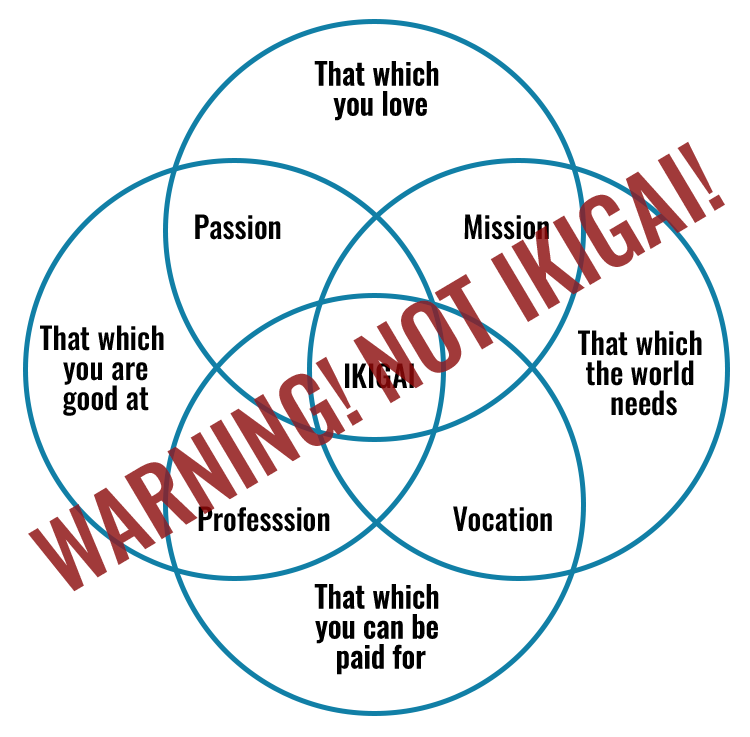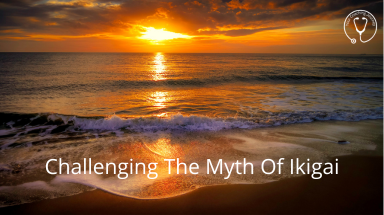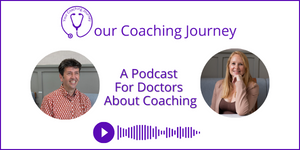Prefer to listen?
This blog post forms the basis of a podcast on our new coaching model, which you can listen to here.
Is Ikigai A Myth?
Helping people to find some meaning in their life and work is often a topic that gets brought to the coaching room. And we frequently see the Ikigai model shared by life coaches, business coaches, and all sorts of different people as a way to help people discover some meaning. While Ikigai does exist as a concept in Japan, so it is isn’t actually a myth, the idea that this diagram is what the Japanese refer to as Ikigai is. Here’s the diagram that we are referring to. We found it ages ago and we’re not sure where it came from originally otherwise we would reference and thank them.
‘Ikigai’ an occupational model designed to help people find a meaningful way to earn a living.
It’s a venn diagram with four intersecting circles that all cross over in the middle.
The four circles that overlap are labelled as:
- what you’re good at
- what you could get paid for
- what the world needs
- what you love
Where the circle that’s labelled ‘what you’re good at’ overlaps with ‘what you could get paid for’, that would be labelled as a profession.
The overlap of ‘what you’re good at’ and ‘what you love’ is labelled as your passion
‘What you love’ and ‘what the world needs’ is labelled as your mission because you’re doing good in the world.
And ‘what the world needs’ and ‘what you can get paid’ for is labelled as your vocation.
The sweet spot is that bit in the middle where you’re good at it, you love it, the world needs it and you can get paid for it all intersect is where, in the Western diagram, ikigai is supposed to exist. Your perfect, purposeful, meaningful way to earn a living.
Oddly, and this is perhaps a little bit of a problem with the model. It doesn’t look at the intersection between three circles, only at all four or the circle separately. So there are some gaps in the model. If, for example, you’re doing something that you love and the world needs and you get paid for it, what’s that? That could be interesting to explore!
It’s quite a useful model if you are engaged in career coaching to talk through with people and to look at where they might find some meaningful purpose in their occupation. But it’s only become Ikigai due to the perpetuation of this diagram. If we use it, we tend to refer to the diagram as a model of meaningful purpose. We don’t call it Ikigai.
Where Does This Incorrectly Titled Model Come From?
The model was created by a Spanish astrologer called Andres Zuzunaga. Who just called it the purpose diagram. And then a business coach from Guernsey called Mark Wynn had seen this diagram and seen that it talked about purpose. He’d also been listening to a TED talk by Dan Buetner, who’s a national geographic researcher and looks at longevity in different cultures around the world.
Enter Dan Buetner and the Blue Zones
He researched the Blue zones in Japan and found people lived very long, happy lives there. And they were looking at some of the reasons why. Some of the reasons are that they eat plant based diet, they also have very tight friendship groups, which we know from sort of positive psychology research is a good indicator of living a long life. But they also have this thing called Ikigai, which is about the reason you get up in the morning, your reason for living, enjoying the small things, what gives you contentment.
That is Ikigai. It’s not necessarily about your occupation, so it doesn’t have to fulfil those four factors in the diagram to be Ikigai. In fact, it’s completely different to the westernised ikigai venn diagram above.
Some of the factors that underpin Ikigai in that Japanese concept are:
- Having an overall vision for your life. But even if there is some mission, some vocation, you’ve got to take small steps towards it. It’s a bit like the Solution Focused Approach to coaching, taking small steps.
- There is also an element of releasing yourself from pressure, not being too preoccupied with getting somewhere that you want to be, or something more than you are at the moment. Being happy with how you are at the moment, engaging with each day in a full way and experiencing life in its fullest.
- Harmony and sustainability is also important. Some of that is about the environment, caring for the world around us, but also maybe helping to empower others to live their best lives. So it’s selfless in that sense.
- And the fourth part is joy in the little things and building that into your life. Maybe taking pleasure in a cup of coffee in the morning, or watching the sunset. Perhaps a bit of mindfulness, just being present in the day and the moment that you are in.
Back To Mark Wynn
Mark Wynn blended the model with this idea of Ikigai, merging the two ideas together. He openly admits he thought it was all very interesting, created this diagram, called it Ikigai and simply wasn’t expecting it to go viral, and take on a life of its own. He holds his hands up and says that he was just playing with ideas.
Can We Still Use This Model?
As you can see, Ikigai in the Japanese sense, is very different from the ‘Ikigai’ model that we see regularly relating to purpose. We’d like to see people referring to that Venn diagram as something other than Ikigai.
It’s a great model if you’re in the world of career coaching, or thinking about your occupation, where you want to go in life, but we just need to stop calling it Ikigai.
If you think about the origins of the intention of it; the Spanish designer of it called it ‘purpose’. So it is a model of meaningful purpose.
Are we being pedants about this?
We think in terms of credibility as a coach, you want to get it right. If a person we’re talking to accepts that it’s Ikigai, because that’s what you’ve told them, then find out later it’s not Ikigai at all, then they may lose some faith in you, which could lead to loss of rapport, or trust and affect your future work together.
And if people just accept this model as Ikigai, maybe they’re missing out on the richness of the true concept of Ikigai as it is in Japan. Making the most of your day, taking joy from each day, starting small. All of those things, all of that richness that comes with the Japanese concept gets lost if people think Ikigai is just one diagram about work.
Meaning and purpose comes up alot in coaching, and work through this and other topics along with many other models and tools on our diploma programme. To find out more about our Doctors’ Transformational Coaching Diploma click through here



